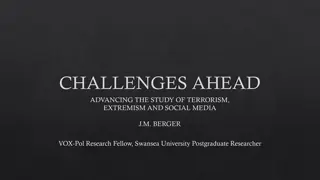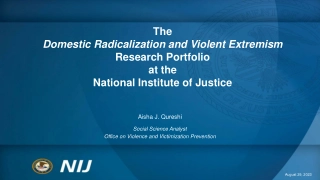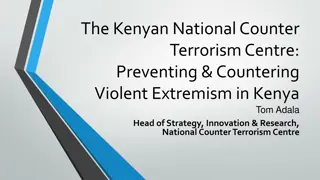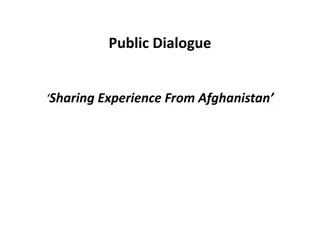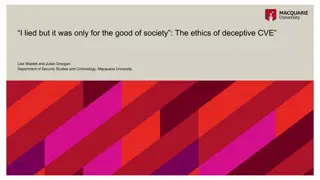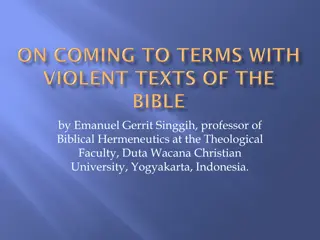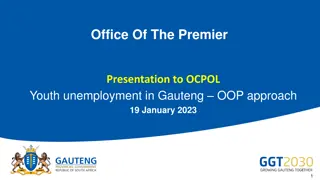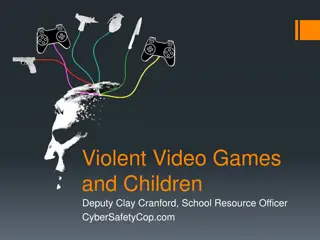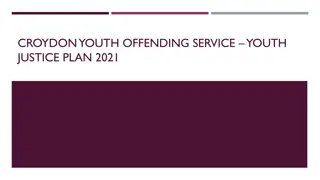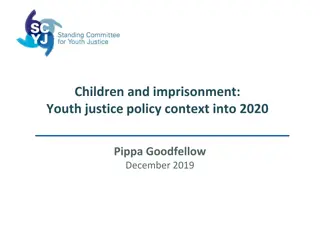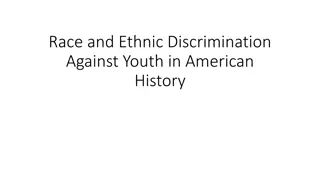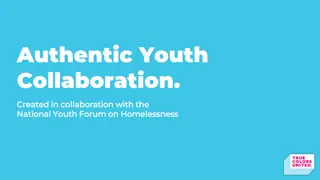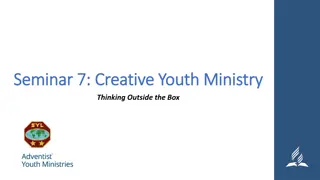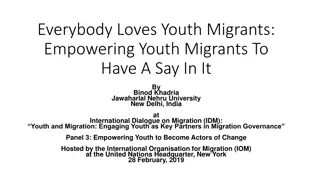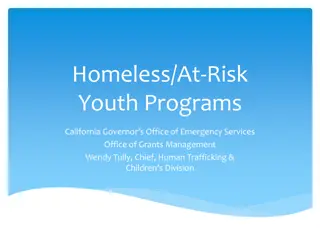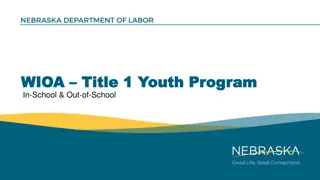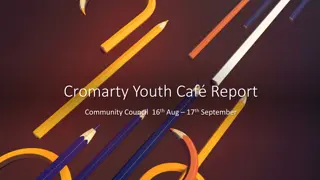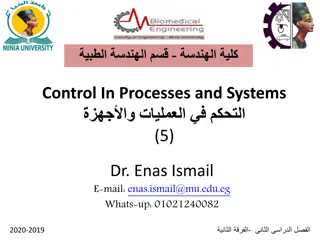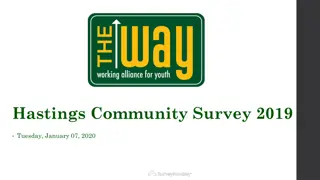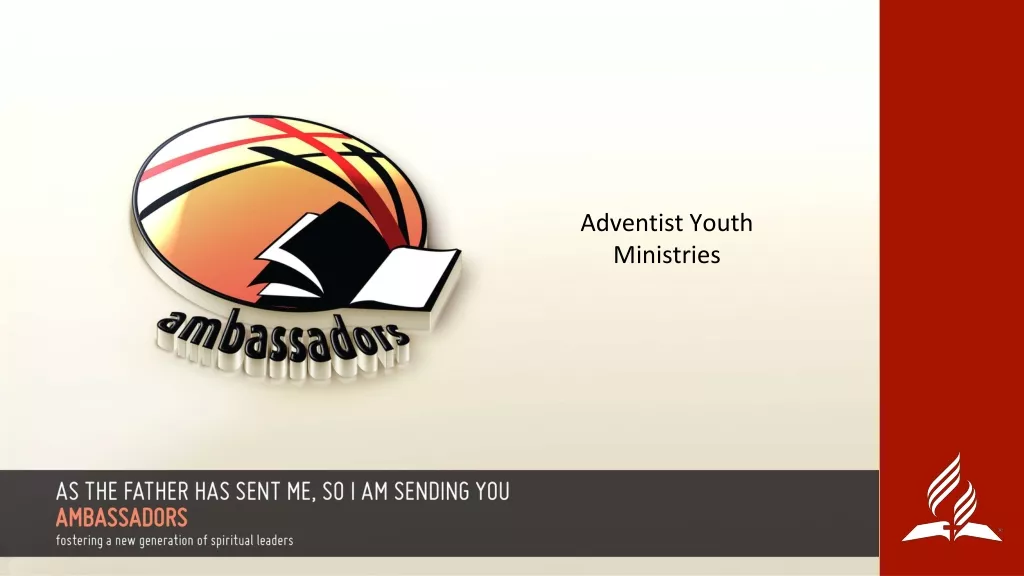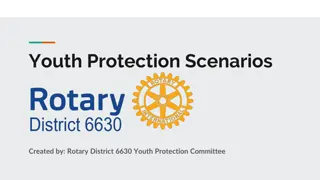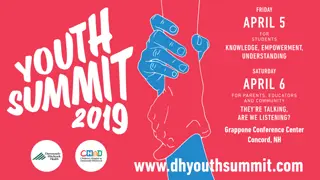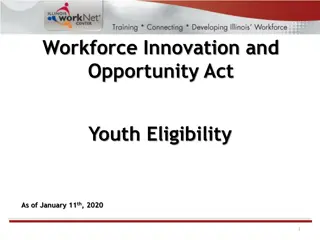Understanding Youth Responses to Online Violent Extremism
Diverse youth responses to online violent extremism are explored in this research, aiming to understand how and why young audiences consume and produce such content. The study delves into how young people define and engage with online violent extremist content, shedding light on their emotional and behavioral experiences and interactions with this material. The research seeks to go beyond one-dimensional perspectives of youth as vulnerable to radicalization, emphasizing the importance of studying audience agency in relation to online extremism.
Download Presentation

Please find below an Image/Link to download the presentation.
The content on the website is provided AS IS for your information and personal use only. It may not be sold, licensed, or shared on other websites without obtaining consent from the author. Download presentation by click this link. If you encounter any issues during the download, it is possible that the publisher has removed the file from their server.
E N D
Presentation Transcript
Vulnerable or just having a laugh?: Diverse youth responses to online violent extremism Dr Julian Droogan & Ms Lise Waldek Department of Security Studies and Criminology
Listening to youth audiences This ARC grant in part aims to understand the following questions: How, why and when youth audiences consume and produce online violent extremist content How do young people themselves define online violent extremist content? How do they experience (emotionally and behaviourally) this type of content? What do they do with this content and why? FACULTY OF ARTS | DEPARTMENT OF SECURITY STUDIES AND CRIMINOLOGY 2
Online violent extremism research: an overview The majority of terrorism research into online violent extremism focuses on content and content producers Research can be categorised into three dimensions: Instrumental usage: How violent extremists use the internet for a range of purposes including recruitment, logistics, fundraising and propaganda Communicative usage: The aims and objectives of content; how content producers create and disseminate messages Technological usage: The intersection of technology with instrumental and communicative aims and objectives The above research has often relied upon a relatively one-dimensional and static conceptualization of the audience FACULTY OF ARTS | DEPARTMENT OF SECURITY STUDIES AND CRIMINOLOGY 3
Dangerous & risky: youth audiences Online audiences have been conceptualized as vulnerable, primed to radicalisation to violent extremism often by cursory demographics including age and religion (Sageman, 2014) Defined as uniform the influence of content on a given audience is perceived as homogenous and instantaneous (Laswell, cited in Jowell & O Donnell, 2015) In particular, youth audiences are often depicted as at-risk . Perceived as particularly vulnerable and highly susceptible to the risks posed by online violent extremism The research has focused on what media does to this audience as opposed to what this audience does with media FACULTY OF ARTS | DEPARTMENT OF SECURITY STUDIES AND CRIMINOLOGY 4
Un-silencing youth audiences An interdisciplinary approach drawing on media and communication studies Audiences are defined as highly dynamic consumers and producers of content. These processes occur in diverse and unexpected ways both emotionally and behaviourally Our research draws from theories of uses and gratification Media use is motivated by the needs and goals as defined by the audience themselves These then influence and are influenced by the gratifications and effects associated by exposure of a given audience to content The theory is explicitly dynamic. It recognises the agency and influence of the audience on the production, engagement and utilisation of online content FACULTY OF ARTS | DEPARTMENT OF SECURITY STUDIES AND CRIMINOLOGY 5
Whether children and young people have experienced extremism online 6 FACULTY OF ARTS | DEPARTMENT OF SECURITY STUDIES AND CRIMINOLOGY
Why children and young people considered what they experienced to be extreme 7 FACULTY OF ARTS | DEPARTMENT OF SECURITY STUDIES AND CRIMINOLOGY
Where online children and young people have experienced extreme content 8 FACULTY OF ARTS | DEPARTMENT OF SECURITY STUDIES AND CRIMINOLOGY
How the extreme content made children and young people feel 9 FACULTY OF ARTS | DEPARTMENT OF SECURITY STUDIES AND CRIMINOLOGY
What children and young people did with the extreme content 1 0 FACULTY OF ARTS | DEPARTMENT OF SECURITY STUDIES AND CRIMINOLOGY
Next steps - focus groups NEW HIGH SCHOOLS Currently ethics applications to continue this research within NSW high schools are under ethics review by Macquarie University and the NSW Dept of Education Focus groups will be carried out in six state high schools across urban and regional NSW Focus groups with 12-17 years olds who have interest in violent extremist materials online will revolve around questions about: Youth led considerations of what is deemed violent extremist online The diverse emotional responses of audiences to this content Rationales behind liking , sharing , commenting , deleting and reporting materials The individual and social context within strategies of resilience operate - i.e. how is this material shared, discussed, evaluated, interacted with, and responded to both online and offline. 1 1
Summary WHAT DO WE KNOW, WHAT MUST WE LEARN? Youth audiences are dynamic. They interact with online extremist and violent materials in a diversity of ways Online environments blend with offline environments - 40% of young people report being online continuously. This is particularly the case with the interface between social media and traditional news media - TV [63%] and online news [43%] remain the primary sources for global news; while social media [51%] and friends [50%] are the primary sources for local news There is no agreement among young people about what counts as extremist material online. Instead there are a diversity of interpretations encompassing religious, political and other domains There are a diverse range of emotional as well as behavioural responses to this material More research needs to be done into what resilience looks like in this space - and especially the degree to which engaging with online violent and extremist materials can demonstrate strategies if resilience 1 2


